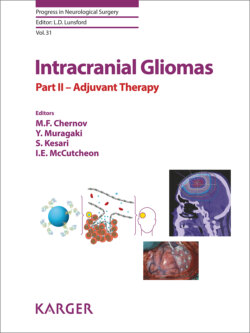Читать книгу Intracranial Gliomas Part II - Adjuvant Therapy - Группа авторов - Страница 30
На сайте Литреса книга снята с продажи.
Glioblastoma-Related Molecular Alterations
ОглавлениеMutations or HD of the tumor suppressor gene PTEN are noted in 14–48% of GBM [31, 37, 50, 51]. The encoded protein PTEN dephosphorylates PIP3 (phosphatidylinositol-3,4,5-triphosphate) to PIP2 (phosphatidylinositol-4,5-bisphosphate) suppressing the PI3K/AKT/mTOR (phosphatidylinositol 3-kinases complex/protein kinase B/mammalian target of rapamycin) pathway, which plays a critical role in cell proliferation and migration and becomes upregulated as a result of PTEN alteration [37]. Inactivation of PTEN requires biallelic loss and represents a late event in astrocytoma progression, but is not associated with EGFR amplification [51]. PTEN loss may be evaluated with IHC using cytoplasmic staining in the endothelial cells as an internal positive control.
Activating mutations or amplifications of EGFR are noted in 30–68% of pGBM and <10% of sGBM, but they are also infrequently seen in AA, and even in some LGG (e.g., in small cell astrocytomas) [6, 9, 12, 13, 31, 36, 37, 50, 51, 65]. High-level EGFR amplification is especially consistent with the diagnosis of WHO grade IV neoplasms [6]. It is mainly encountered in lesions carrying wild-type TP53[49], and is more typical in the elderly patients [6]. The encoded transmembrane tyrosine kinase receptor is involved in cell proliferation, invasion, and tumor resistance to irradiation and chemotherapy [6]. In 10–67% of cases EGFR amplification in GBM is associated with its rearrangement, characterized by deletion of exons 2–7 resulting in a sense mutation and encoding of the truncated extracellular domain with ligand-independent constitutive activity designated as EGFR variant III (EGFRvIII) [37, 51, 65]. Detection of EGFR amplification is usually performed with real-time PCR or FISH, since IHC provides non-specific results.
Activating mutations or amplifications of PDGFRA are identified in 7–40% of GBM, being significantly more frequent in lesions carrying IDH1/IDH2mutations [9, 13, 35, 37]. The encoded cell surface tyrosine kinase is similar to EGFR and also regulates cellular proliferation, differentiation and growth, as well as stem cell renewal [37]. The optimal method for evaluating PDGFRA alterations is FISH, since it allows assessment of both low- and high-level amplifications [35].
Entire loss of chromosome 10 has been specifically observed in pGBM [61]. LOH of chromosome 10q is seen in 50–90% of pGBM and 50–70% of sGBM, and is frequently combined with gains of chromosome 7 (+7q/–10q or +7p/–10q) [9, 12]. Other widely recognized molecular events in GBM include inactivating mutations or HD of NF1 (neurofibromin 1; located at 17q11.2), CDKN2B (cyclin-dependent kinase inhibitor 2B; located at 9p21) and RB1, amplifications of CDK4, CDK6 (located at 7q21-q22) and MDM2, and LOH of chromosomes 9p, 10p, 13q, 17p, and 22q [13, 49, 61].
Despite the importance of all these genetic and cytogenetic abnormalities in tumorigenesis, their distinct prognostic or predictive values in GBM remain uncertain [35–37, 50, 65]. This uncertainty may be particularly related to the difficulty of their assessment due to prominent inter- and intratumoral heterogeneity of the acquired molecular alterations [32]. Nevertheless, the presence of EGFRvIII mutation may be negatively associated with long-term survival rates [65] and may constitute a molecular basis for specific tumor vaccine therapy [66], whereas PDGFRA amplification may eliminate the positive prognostic impact of IDH1/IDH2 mutations in pGBM in adults [35]. Moreover, identification of such molecular abnormalities in histologically lower-grade gliomas should be considered as a possible sign of aggressive biological behavior, similar to that seen in WHO grade IV tumors [6, 9]. Of note, mutations in the cell cycle regulators have been identified in 18.6% of WHO grade II and III gliomas, and mainly in those carrying wild-type IDH[32].
